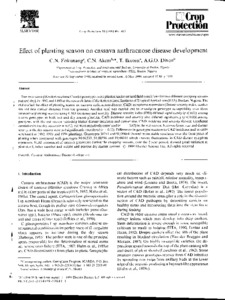| dc.contributor.author | Fokunang, C.N. |
| dc.contributor.author | Akem, C.N. |
| dc.contributor.author | Ikotun, T. |
| dc.contributor.author | Dixon, Alfred G.O. |
| dc.date.accessioned | 2019-12-04T11:23:37Z |
| dc.date.available | 2019-12-04T11:23:37Z |
| dc.date.issued | 1999 |
| dc.identifier.citation | Fokunang, C.N., Akem, C.N., Ikotun, T. & Dixon, A.G.O. (1999). Effect of planting season on cassava anthracnose disease development. Crop Protection, 18(6), 407-413. |
| dc.identifier.issn | 0261-2194 |
| dc.identifier.uri | https://hdl.handle.net/20.500.12478/4070 |
| dc.description.abstract | Twelve cassava (Manihot esculenta Crantz) genotypes were planted under natural field conditions for two different cropping seasons (wet and dry), in 1992 and 1993 at the research farm of the International Institute of Tropical Agriculture (IITA), Ibadan, Nigeria. The trial studied the effect of planting season on cassava anthracnose disease (CAD) symptoms expression (disease severity index, canker size and first canker distance from the ground). Another trial was carried out to investigate genotype susceptibility over three consecutive planting seasons using CAD incidence and severity. Disease severity index (DSI) differed significantly (p⩽0.05) among cassava genotypes in both wet and dry season planting. CAD incidence and severity also differed significantly (p⩽0.05) among genotypes, with the wet season recording higher disease incidence and canker size. CAD incidence and severity showed significant correlation in the dry season (r=0.91), but were negatively correlated (r=−0.87) in the wet season. Necrotic lesion size and disease severity in the dry season were not significantly correlated (r=0.23). Differences in genotypic reaction to CAD incidence and severity were found in 1992, 1993 and 1994 plantings. Genotypes 30211 and 91/00684 showed more stable resistance over the three years of planting when compared with genotypes 90/00333, 91/00396 and 89/00011 which showed fluctuations in CAD disease symptom expression. Yield assessment of cassava genotypes during the cropping seasons, over the 2-year period, showed great variation in plant stand, tuber number and weight and percent dry matter content. |
| dc.language.iso | en |
| dc.subject | Cassava |
| dc.subject | Anthracnosis |
| dc.subject | Manihot Esculenta |
| dc.subject | Genotypes |
| dc.subject | Cropping Systems |
| dc.subject | Diseases |
| dc.title | Effect of planting season on cassava anthracnose disease development |
| dc.type | Journal Article |
| dc.description.version | Peer Review |
| cg.contributor.crp | Roots, Tubers and Bananas |
| cg.contributor.affiliation | University of Ibadan |
| cg.contributor.affiliation | International Institute of Tropical Agriculture |
| cg.coverage.region | Africa |
| cg.coverage.region | West Africa |
| cg.coverage.country | Nigeria |
| cg.isijournal | ISI Journal |
| cg.authorship.types | CGIAR and developing country institute |
| cg.iitasubject | Cassava |
| cg.iitasubject | Crop Systems |
| cg.iitasubject | Plant Diseases |
| cg.accessibilitystatus | Limited Access |
| local.dspaceid | 99356 |

